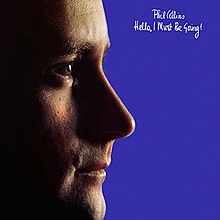Hello, I Must Be Going! (album)
| Hello, I Must Be Going! | ||||
|---|---|---|---|---|
 |
||||
| Studio album by Phil Collins | ||||
| Released | 5 November 1982 | |||
| Recorded | May–September 1982 | |||
| Studio | Old Croft | |||
| Genre | ||||
| Length | 45:03 | |||
| Label |
Virgin (UK, Ireland) Atlantic (North America) WEA (Rest of the world) |
|||
| Producer |
Phil Collins Hugh Padgham |
|||
| Phil Collins chronology | ||||
|
||||
| Singles from Hello, I Must Be Going! | ||||
|
||||
| 2016 reissue cover | ||||

Recreated cover photograph, as part of Collins' 2016 studio album reissues
|
||||
| Professional ratings | |
|---|---|
| Review scores | |
| Source | Rating |
| AllMusic | |
| PopMatters | 7/10 |
| Q | |
| Rolling Stone | |
| Rolling Stone (DE) | |
| Scunthorpe Telegraph | 8/10 |
| Uncut | 8/10 |
Hello, I Must Be Going! is the second solo studio album by English singer-songwriter Phil Collins. The album was released in late 1982 on Virgin in the UK and Ireland, Atlantic in North America, and WEA in the rest of the world. The album was promoted with a tour of the same name. The album brought Collins his first nomination for British Male Artist at the Brit Awards in 1983.
Nine of the album's ten tracks made some sort of chart worldwide, with a cover version of The Supremes' "You Can't Hurry Love" the album's most significant hit. Other tracks include the modern-jazz instrumental "The West Side", and "Thru These Walls", a dark voyeuristic song about a man listening through the wall to his neighbours partaking in unseemly nighttime activities. The dark "I Don't Care Anymore" reached No. 39 in the U.S., giving Collins his first Grammy Award nomination for Best Rock Vocal Performance, Male in 1984.
The album is named after the Marx Brothers' song of the same name, featured in their 1930 movie Animal Crackers.
AllMusic critic Stephen Thomas Erlewine said: "Phil Collins began to inject his highly melodic pop songwriting with more soul and R&B influences on his second solo album, Hello, I Must Be Going! While some of the material was successful, much of it showed that he was still coming to grips with how to incorporate R&B techniques into his style." In Rolling Stone, critic John Milward wrote of the album: "Despite its trend-bucking boast of an eight-track recording, the album's rich luster is of the old classical-rock school. In fact, the LP sounds like stripped-down Genesis, ornamental but not too ostentatious."
...
Wikipedia
